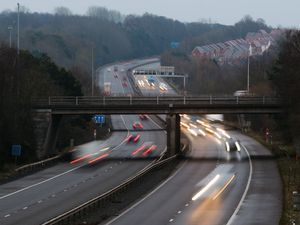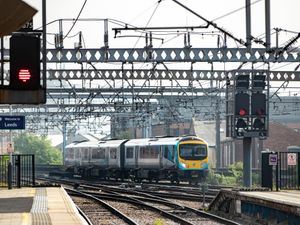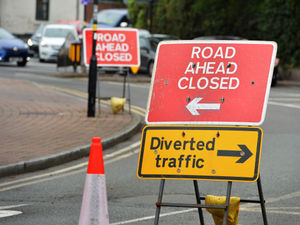HS2 debate: High speed rails or nature trails?
Supporters say it will herald a new era of travel to make travelling between the Midlands and London easier than ever before.
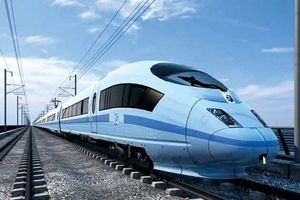
But to get there so quickly, the trains on the HS2 line will have to cut across fields and houses.
Whether you think the disruption is worth it for the benefits the £50 billion project will bring, probably depends on where you live.
Communities in Staffordshire say their lives are being ruined and that they are being forced to give up their family homes.
The high speed line will cut through 46 miles of the county's countryside, reaching from Lichfield in the south eastern corner of the county up to Madeley in the north west.
And it will hit businesses such as Whittington Golf Club, as the seven-mile stretch between Whittington and Handsacre will see the demolition of the Victorian club house.
The ancient woodlands at Ravenshaw Wood, Vicar's Coppice and Tomhay Wood are three of the 67 ancient woodlands threatened by HS2.
The line cuts through Handsacre, Colton and Stockwell Heath close to Blithfield Hall, a Grade I listed building and home to the Bagot Family, who have resided at the estate since the late 14th century.
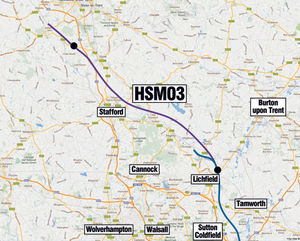
The tracks then slice through the village of Great Haywood – once home to Lord of the Rings author JRR Tolkien.
The trains will cross a marina home to dozens of narrow boats and then hem the northern boundary of the historic grounds of Shugborough Hall. At nearby Ingestre the line will cut through the village's renowned members-owned golf course, and pass just 400m in front of the grand Ingestre Hall Jacobean mansion owned by Sandwell Council as a wedding venue and arts centre.
But instead he has vowed to stay put – and has become locked in a battle with bosses.
Their home borders the proposed HS2 link to the West Coast Main Line, which entitles them to have their property bought by HS2 Ltd so that they can move.
They want to rebuild on other land within their farm, but there are hurdles because the farm is in a green belt area.
Lichfield District Council's planning policy means permission to build will only be granted upon demolition of the existing farmhouses, and chiefs claim the existing buildings may be suitable for sale or rent to other residents once the project completes.
The council has agreed that the Sadlers can build a replacement farmhouse on their land, further away from the high speed line and HS2 Ltd have agreed to pay compensation and the costs of building a new home.
However, this is only honoured if the developers can take possession of the original home which will be alongside the track.
But council officials are demanding that the original home be demolished because it is in green belt and an additional home is not permitted.
Mr Sadler said: "HS2 don't consider the impact on people's lives and what it can do to someone knowing this line is coming."
Lichfield MP Michael Fabricant has taken up the fight for the Sadlers. He said: "How can an area of land remain designated as green belt when a ruddy great railway line is running through it?"
The issue has now gone to the Government's HS2 committee, who will make a decision on what to do.
David Cliffe and his sister Joy Fielding of Common Farm near Lichfield are hit by both Phase 1 and Phase 2. They both attended protests at the House of Commons to attempt to convince MPs to vote against the HS2 bill.
HS2 bosses say they have made a number of changes following residents' concerns, including making the line go under the A38, the West Coast Main Line and the South Staffordshire line, rather than run over them on viaducts.
Some 92 homes worth £53 million across the Midlands have already been snapped up to make way for HS2.
HS2 Ltd, the government-owned company behind the high-speed rail line, has bought 43 properties in Staffordshire worth £26.29 million, 14 in the West Midlands worth about £10 million, and 35 in North Warwickshire worth nearly £18 million.
And they have also agreed to purchase another 68 homes across the region under deals that do not have to completed until construction on the line starts.
The 225mph trains HS2 promises from 2026 are expected to cut journey times between Birmingham and London to around 45 minutes.
But campaigners argue that this will only matter to people with enough cash to pay for the tickets - and that the proposed economic benefits will not reach the man or woman on the street.
Fighting high speed rail has become a full time job for groups like Stop HS2, while Staffordshire Wildlife Trust launched a public appeal to raise £17,500 to cover the costs it will incur through extra staff time, legal fees and extra habitat surveys.
The proposed Phase 1 and Phase 2 routes will pass 46 miles through Lichfield, Stafford and Newcastle-under-Lyme boroughs, and could affect over 5,500 acres of land; about 2,000 acres larger than all Staffordshire Wildlife Trust's nature reserves combined.
In total, 27 wildlife sites will be directly affected in Staffordshire as part of the HS2 plans.
Figures show that about 2,026,575 tons of agricultural land will have to be excavated across 800 acres in the Lichfield area alone as part of the first phase, which is set to join up with the West Coast Main Line in Handsacre, while the second phase to Manchester, would carve through countryside stretching from Lichfield to Stone.
HS2 Ltd said 400 acres of the land between Whittington and Handsacre will be restored and available for agricultural use following construction.

But anti–HS2 campaigner Trevor Forrester, who lives in Ingestre, said: "Apart from the fact HS2 is a colossal waste of money, they seem to have chosen a route that will do the most environmental and visual damage to our countryside."
The Department for Transport produced a huge document called the 'environmental impact assessment' to lay out the work that was being done to reduce the impact on the countryside.
However the wildlife trust claims important species such as deer have not been considered. And they have called on bosses to plan a 'living landscape' around the route, to create areas where wildlife can survive.
Nationally, depots and railway hubs will be built on 250 acres of green-belt land. Green belt land will have to be crossed west of Newcastle-under-Lyme, north of Northwich, along a spur into Manchester and outside Nottingham, Sheffield and Leeds;
Around 25 miles of the line will be built on floodplains and it is believed more than 600 homes will be knocked down.
HS2 Ltd spokesman Ben Ruse said: "We have already committed to putting two thirds of the route from London to Birmingham in tunnel or cutting and will continue to work with residents to minimise the impact on the local community. In Staffordshire we have responded to local concerns by lowering the line as it passes Lichfield, thus significantly lessening the impact on the city, and on the setting of the Trent and Mersey Canal.
"As a first principle, we have pledged to replace lost habitats on a one for one basis, so if we lose a wood, we'll plant a new one. If we drain a wetland, we'll create a new one. By the end of it all, we expect to have planted close to four million trees along the line.
"I think that says something about the scale of our ambition. At the end of the day, HS2 isn't just a railway line, it's an investment in our future prosperity, a bold and ambitious attempt to solve to the twin problems of rail capacity and the growing north-south divide."
But campaigners will continue their fight - and the saga will go on for years to come yet.

Stop HS2 leader Joe Rukin said: "David Cameron has shown he has clearly never actually been on a train, as every time I am on a train through a city I see industrial graveyards crying out for redevelopment. They already have transport links and populations willing to work, but they are simply not where developers want to build, as the green belt is a cheaper option with better profit."

